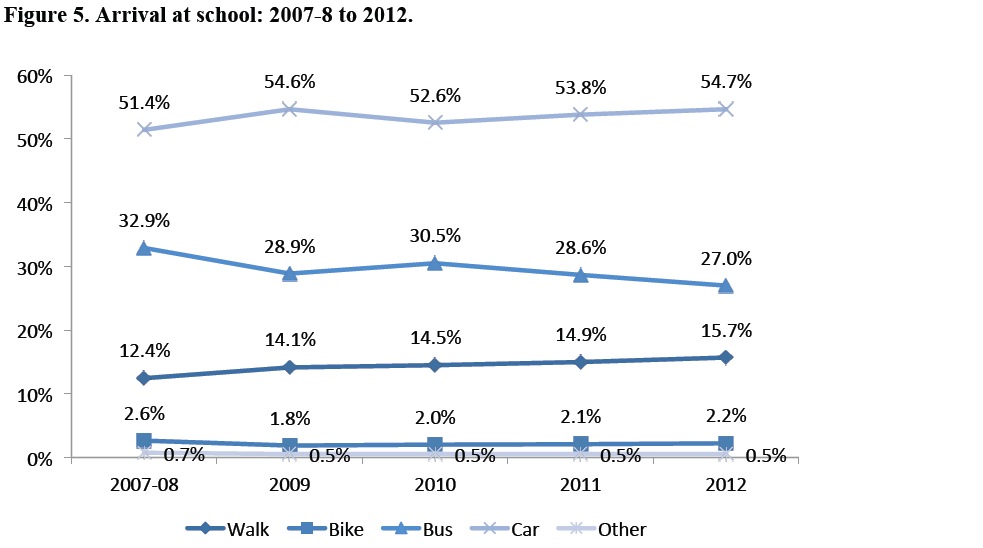SAFE ROUTES TO SCHOOL NATIONAL PARTNERSHIP
Executive Summary
The Federal Safe Routes to School (SRTS) program was created with the enactment of the SAFETEA-LU transportation legislation in August 2005. In May 2006, the National Center for Safe Routes to School (National Center) was established with funding from the Federal Highway Administration (FHWA). Shortly thereafter, under the direction of FHWA, the National Center created standardized data collection instruments and began offering data processing services to all schools that collected school travel data using the instruments. These data provided a unique opportunity to analyze school travel patterns and to acquire an understanding how school- and household-level factors might have influenced school travel mode choices. This report describes a series of analyses involving parent survey data collected by schools throughout the United States starting in the year 2007 and through 2012. After linking parent survey data with school-level information from the National Center for Education Statistics, more than 525,000 parent surveys from nearly 4,700 schools located within all states and the D.C. were included in the analyses.
To examine student travel patterns and parental perceptions of active school travel over time, multinomial logit models which clustered responses by school were estimated. These models estimated the probability of choosing school travel modes as a function of school-level and household-level predictor variables. School-level variables included school income and the Census-defined locale in which a school was located. Household-level variables included students’ sex and grade in school, distance the student lived from school, parents’ level of education, whether the student asked parents for permission to walk or bicycle between home and school, how much fun parents perceived walking and bicycling to be for their child, how healthy walking and bicycling was for their child, and how much their child’s school supported walking and bicycling to/from school.
Key findings from the analyses include:
- Walking to and from school increased significantly between 2007 and 2012. From 12.4% to 15.7% in the morning; and from 15.8% to 19.7% in the afternoon.
- Although walking increased among students who attended low-, medium- and highincome schools, walking increased especially among students who attended low-income schools (defined as enrolling 75% of students who were eligible to receive free or reduced price meals).
- Boys and girls were equally likely to walk to/from school.
- There was a small but significant decrease in bicycling to school between 2007 and 2012, from 2.6% to 2.2% in both the morning and afternoon.
- Boys were twice as likely to ride a bicycle to/from school as were girls.
- Busing decreased significantly between 2007 and 2012. Within one mile of school, the largest shift between travel modes occurred between busing and walking, with busing decreasing significantly and walking increasing significantly.
- Between 2007 and 2012, the percentage of parents who stated that their child’s school supported walking and bicycling between home and school increased from 24.9 to 33 percent.
 Download full version (PDF): Trends in Walking and Bicycling to School
Download full version (PDF): Trends in Walking and Bicycling to School
About the Safe Routes to School National Partnership
www.saferoutespartnership.org
“The Safe Routes to School National Partnership’s mission is to advance safe walking and bicycling to and from schools, and in daily life, to improve the health and well-being of America’s children and to foster the creation of livable, sustainable communities.”
Tags: Bicycling, Cycling, FHWA, Pedestrian, Safe Routes to School National Partnership, SAFETEA-LU, SRTS






 RSS Feed
RSS Feed
While walking and riding bikes to school is a great way to improve children’s health and to decrease school district costs by reducing the transportation expenses, there are serious safety concerns. In my particular community, Byers, CO, quite a few children walk and ride bikes to school. They are required to walk across U.S. Highway 36, across train tracks, and alongside various streets to get to school. There are no crossing guards to assist; nor are there any designated walking paths or sidewalks to facilitate the walk-ride requirements of the school district. Many of the children seen walking to school in the morning are very young and have no adults with them. How do we go about getting the county — if they are the ones to designate and build sidewalks and walking paths — to improve the situation? This community is unincorporated; thus, there is no local government or budget to help, aside from the county.